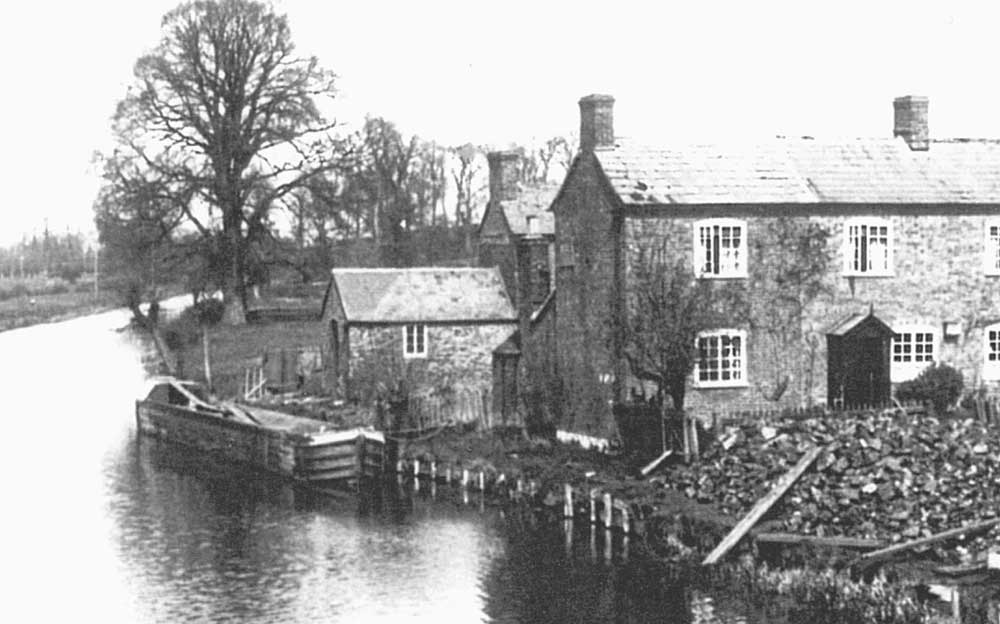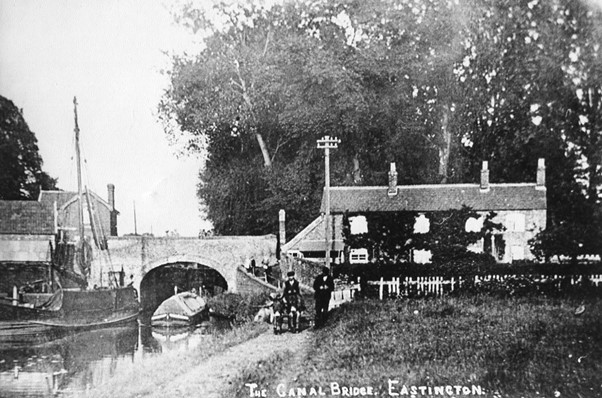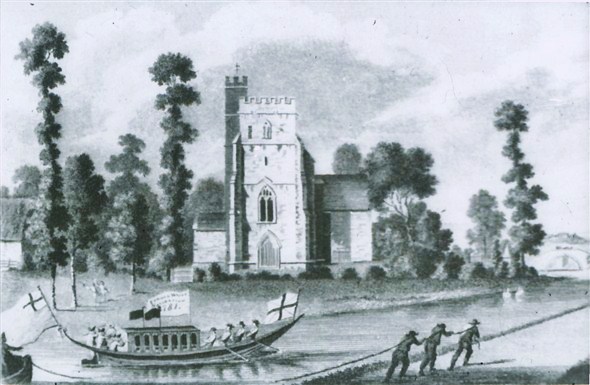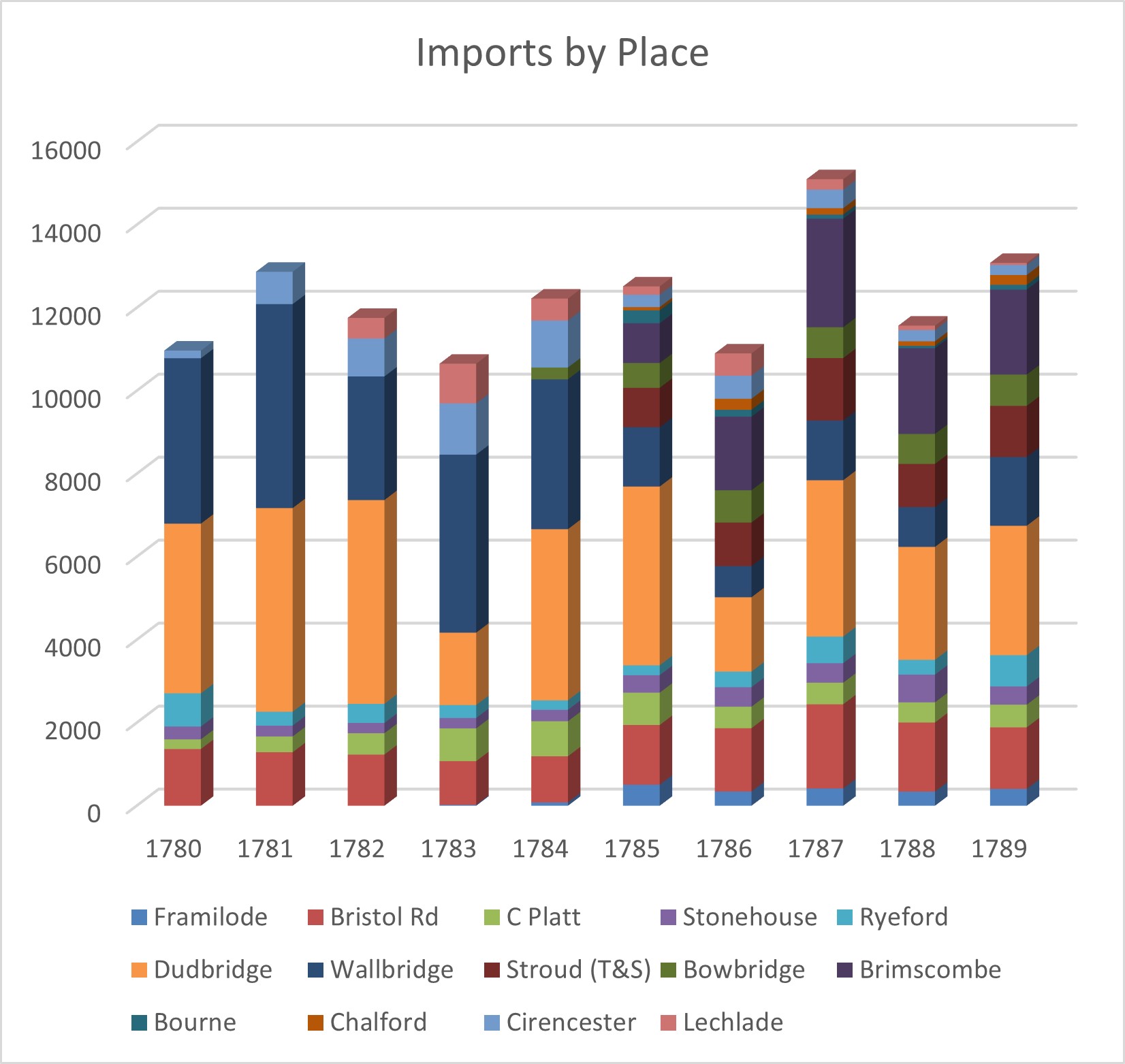Martin Bryan highlights the main cargoes sent to and from the Stroudwater Canal from its opening in December 1776 till the end of the century.
1776-1777 - Framilode to Bristol Road


The first chargeable cargo of coal was landed at Bristol Road Wharf on the 12 December 1776, and by the end of the year 399 tons of coal had been landed at the wharf. During 1777 a further 9550 tons of cargo, mostly coal, was landed at the Wharf. The first outgoing cargo was 13 tons of cheese loaded in April, but only another 73 tons of goods are recorded as going downstream from Bristol Road.
The majority of the coal (7035 tons) came down the Severn from the Shropshire fields around Ironbridge. 639 tons of Staffordshire coal came down the Staffordshire and Worcestershire Canal to Stourport and then down the Severn. Only 167 tons came across the river from the Forest of Dean, while 284 tons came up the Bristol Channel from Tenby. For 1249 tons of coal no source was recorded.
Other incoming cargoes included 27 tons of bricks, 20 tons of stone, 58 tons of 'stinkers' and 4 tons of wool. Outgoing cargoes included 79 tons of timber and bark, 1 ton of cyder and 2 tons of 'household goods'.
The main consignees for coal were Grazebrook & Co (4713 tons) and Samuel Collins, wharfinger at Bristol Road, (4509 tons). Other coal traders included Mr Palmer (331 tons) and Samuel Stephens (53 tons of coal and 16 tons of Stourbridge bricks).
During this period a single charge of one shilling (5p) a ton was made for all cargoes. Total income for 1776-1777 was £507.
What happened to the 10,000 tons coal? Bristol Road Wharf is 3 miles from Stonehouse, 6 miles from Stroud, 9 miles from Nailsworth and 10 miles from Chalford. A letter from James Bough in 1777 gives the cost of moving a waggon of coal from Bristol Road to Stroud as 10 shillings. If the average load for a waggon was 2-3 tons, some 3-4000 loads would have needed to travel along the Stroud Turnpike, which ran from Framilode Passage, via Whitminster Cross toll gate, to Stroud. Traffic jams at Cainscross toll gate may have occurred on busy days.
1778 - Opening of the wharf at Chippenhams Platt


In November 1777 the committee ordered that "an acre of Mr Stephens's land next to West Field be measured and enclosed for the Coal Wharf". The location, between Westfield Lock and Dock Lock, was referred to at the time as Chippenhams Platt. Later it became the company's maintenance yard and a new coal wharf was built adjacent to Pike Lock and the turnpike to Eastington.
The minutes for 8 January 1778 record that Joseph Grazebrook "has leave to Build a Temporary Warehouse on the waste Land at Chippenhams Platt he finding all the Materials and Building at his own expence." He was charged £3 for rent up to Xmas 1779. A load of lead and timber was recorded as being landed at the site on 1st January 1778, but the first load of 44 tons of coal only arrived on 14th January, with regular shipments starting from the 26th January.
Goods to Chippenhams Platt were charged at 1s 6d (7.5p) a ton, 50% more than to Bristol Road. But by March this differential was eroded as the toll to Bristol Road was raised to 1s 3d. A total of 4851 tons of goods were taken to Chippenhams Platt against 3492 to Bristol Road. The income from tolls was £580. It was noticeable that during May many boats had to unload some of their cargo at Bristol Road before continuing up to Chippenhams Platt, presumably because of lack of water in the upper pound.
Again most of the trade was in coal, with 5986 tons of Shropshire coal, 1535 tons of Staffordshire coal. 308 ton of Tenby coal, 227 tons of Forest of Dean coal, 190 tons of Darby and 14 tons of Bristol coal. Only 155 tons of other goods were received. The only outbound trade was 2 tons of Shropshire coal sent to Bristol.
The principal consignees remained Grazebrook & Co (2916 tons), Samuel Collins (2630 tons), Samuel Stephens (2159 tons) and Mr Palmer (202 tons)
1779 - Onward to Stroud


By January 1779 the canal was open to Ryeford, where a charge of 2s per ton (raised to 2s 2d in April) was enough to make transport there competive. After July the canal was fully opened with charges for coal of 2s 11d per ton for Dudbridge and 3s to Stroud, though higher prices were charged for other cargoes, such as wool and salt (up to 3s 8d to Dudbridge or 4s to Stroud).
In the first half of the year Ryeford received 3212 tons of cargo, but only 50 tons after the opening of the upper pounds. In the second half of the year Dudbridge received 885 tons and Stroud 1254. Lower down the canal Bristol Road still received 353 tons, Chippenhams Platt 83 tons, Whitminster 56 and Stonehouse 15. Above Ryeford cargoes also went to Oil Mills, Ebley and Lodgemore. Only 50 tons of goods travelled down the canal. Income from tolls for the year was £713.
Shropshire coal was again the most common cargo, 3725 tons, against 935 tons of Staffordshire coal, 815 tons of Forest coal, 160 tons of Tenby coal and 120 tons of other coals. There were 96 tons classed as Sundries, which were charged at the highest rates, and 235 tons of other types of cargoes.
Grazebrook & Co with 2732 tons and Samuel Stephens with 2168 tons were again the main traders, while Thomas Pearce at Dudbridge received 358 tons of coal from the Forest of Dean. Cargoes also went to 22 other consignees.
The first decade - 1780-1789


In November 1779 a petition was presented to the House of Commons for the creation of a new turnpike leading from Dudbridge up the valley to Nailsworth and then on to Tiltputs Inn, to join the existing Horsley to Tetbury turnpike. The Nailsworth Trust Act received Royal Assent on 21st March 1780, and the newly built road, which served 14 mills, was approved by the trust committee on 30th May 1781.
The warehouse at Wallbridge was let to William Wakefield in March 1780, and the wharfs at Wallbridge and Dudbridge were fenced in. Grazebrook & Co had their warehouse at Dudbridge. Agreement for the land needed for a wharf at Stonehouse Cross was not reached until 1785, when the wharf at Wallbridge was walled in.
When new rates were set, in October 1779, a drawback of 1s per ton was allowed on coals carried to Cirencester, Tetbury or Lechlade while goods carried down the Severn to Stroud or exported up the Severn from Stroud were given preferential rates. Preferential rates were also applied to certain mill owners. From 1782 a special rate of 1s per ton was applied to goods, such as cannons, brought to Stroud for onward transmission to London via Lechlade.
The first cargo to go up the Thames & Severn Canal, though only as far as Bowbridge, was in July 1784. By July 1785 the new canal had reached Chalford, but the building of the canal was not completed through to Inglesham until 1789. Rates for cargoes to be sent up the new canal were much lower than on the Stroudwater itself as the Thames & Severn Canal charged 1s 3d for cargoes below Brimscombe. For example, a ton of coal to Wallbridge in 1785 could cost 3s 6d (17½p) in Stroudwater tolls, while one to Brimscombe Port would only garner 1s (5p) for the Stroudwater Navigation.
During the decade a total of 54,804 tons of Shropshire Coal, 45,168 of Staffordshire Coal, 3479 of Forest Coal and 2865 of Tenby Coal were imported up the canal. 5920 tons of Stone was transported, much of it down the canal to Gloucester for use in building the new prison. A total of 2935 tons of salt were imported, mostly for the use of Mr Clutterbuck at Dudbridge and Mr Freebury in Stroud. Bricks (934 tons), timber (804 tons) and wheat (690 tons) were the other major components of the 128,000 tons imported and 7825 tons exported along the canal during this decade. Perhaps the most surprising export, though, was the 739 tons of Gun Stocks sent up the Severn during this decade to help replenish the army following the American War of Independence.
Of this tonnage, 35,400 tons went up to Dudbridge, 26,000 to Wallbridge, 14,200 was distributed from Bristol Road, 5600 from Chippenhams Platt, and 4500 from Ryeford. Only 3800 tons were unloaded at Stonehouse, while another 2100 tons was unloaded at Framilode. Over 6000 tons was awarded a drawback for being delivered more than 10 miles for Dudbridge and Wallbridge, while 3000 tons made it as far as Lechlade. Within the Stroud Valleys served by the Thames and Severn Canal 5770 tons was unloaded at the wharf above the Wallbridge Lock in the centre of Stroud, 3880 tons were unloaded at Bowbridge, 9450 at Brimscombe, 750 tons at The Bourne and 840 tons at Chalford.
Thomas Cullis brought some 8500 tons of Shropshire Coal from Coalbrookdale. Various members of the Oakes family also brought almost 8000 tons of Shropshire Coal into the Stroudwater Navigation, Richard Tolley carried some 6000 tons of Staffordshire Coal while John Longney carried over 2000 tons of Forest Coal for Collins. Members of the Pugh family brought over 1500 tons of salt from Droitwich. Richard and Thomas Davis brought some 600 tons of Road Stone to Bristol Road and Chippenhams Platt, while Joseph Corbett supplied over 2500 tons of Stone from the upper Stroud Valley for the building of Gloucester Prison.
By the end of 1789 the Company of Proprietors of the Stroudwater Navigation had taken £18,350 in tolls. By 1783 most of the loans taken out to augment the amount raised from the sale of the 200 original subscriptions, and the calls of £150 per share on these, had been paid off. In 1789 dividends of £7.50 per share (5%) were paid on each share.
The effect of the opening of the Thames & Severn Canal - 1790-1799


Once the Sapperton Tunnel was opened in 1789 through traffic to Cirencester and Lechlade became possible. As boat width and length changes were required for boats going beyond Brimsombe goods for destinations beyond Chalford were mostly transhipped in Brimscombe Port. But until the Thames & Severn Canal built a windmill to pump water into the top level of their canal in 1790 there was insufficent water in the canal during the summer. In 1792 the supply was augmented by a Boulton & Watt beam engine.
As the decade progressed the poor condition of the horse towing path built in 1772 between Coalbrookdale and Bewdley, and the lack of a path from there to Stourport, significantly reduced the amount of Shropshire Coal reaching Gloucestershire, while increasing amounts of Staffordshire Coal were being sent to the Thames to compete with coal coming down the Oxford Canal from around Coventry.
During the decade 166,200 tons of Staffordshire Coal were imported, but only 24,797 tons of Shropshire Coal, 6202 tons of Tenby Coal and a mere 1417 tons of Forest Coal were imported. There was more Smiths Coal than Forest Coal, and a small amount of Newport Coal. 7700 tons of salt was imported from Droitwich, and 5300 tons of stone was imported.
Because merchant shipping around the coast of southern England was being threatened by French vessels and, more significantly, Royal Navy pressgangs, there were significant new cargoes in the form of Iron (9000 tons), Copper (6462 tons), Tin (4600 tons) and even Guns (3500 tons), much of it from South Wales and the River Wye. Another significant new cargo was Cider, for which over 2000 tons were sent to Brimscombe for eastwards transhipment.
As the overall tonnage increased the amount of detail recorded in the tonnage books decreased as more and more cargoes were treated as Sundry Goods, often sent to Sundry People at Sundry Places. In 1799 28% of cargoes were unspecified, 20% were not consigned to anyone, and 13% had no destination specified.
The 28,200 tons of goods exported westwards from the Stroudwater went to many places, including Bath, Bewdley, Bristol, Gloucester, Monmouth, Newnham, Redbrook, Upton-on-Severn, Worcester and, most often, to Stourport. The majority of the cargoes in the latter half of the decade originated in Brimscombe.
Of the imports, twice as many went to destinations on the Thames and Severn Canal at to ones on the Stroudwater Navigation. A total of 147.950 tons had their destination specified as being Brimscombe Port. Needless to say the main consignee for the decade was William Hill at Brimscombe Port.
A total of £25,550 was taken in tolls and rents during the decade. Despite traffic almost trebling, the overall profit per year only doubled as the rates charged for traffic going into the Thames and Severn Canal was much lower than for goods delivered on the Stroudwater Navigation.
In 1799 the dividends paid to shareholders came to £13 per share, a return of over 8%, though the average return over the decade was just over 5%.
More information about trade on the canal, including its historical background and tables and graphs summarizing the trade, is provided in Martin Bryan's paper on 18th Century Trade on the Stroudwater Navigation. A study of the increased trade in metals through the canal to the Thames & Severn Canal and locations towards London is provided in Metal transport through the Stroudwater Navigation in the 1790s.